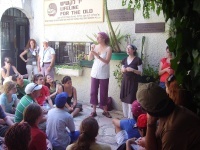c. 2008 Religion News Service
JERUSALEM _ When Kyle Edenzon showed up for his first day of Hebrew school as a young boy, his parents asked the teacher to place their hard-of-hearing son in the front row to better help him understand the lessons.
“But as soon as they left, the teacher put me in the back and basically said, `You’re on your own,”’ said Edenzon, 21, of Northridge, Calif. “I was maybe 5 years old and cried hysterically. I didn’t go back till I was 11 or 12.”
For many deaf and hard-of-hearing Jews, Edenzon’s experience unfortunately isn’t that unusual. Deaf interpreters are expensive and sometimes hard to come by, and many synagogues simply aren’t equipped to work with deaf students.
The result, observers say, are young Jews who lack the religious education that so many take for granted _ especially in a tradition that places so much emphasis on the (spoken) language of prayer and sacred chanting.
As he gathered with other young pilgrims in the shady courtyard of an arts center for elderly and disabled Jerusalemites, Edenzon clutched a hand-woven prayer shawl with a newfound tactile sense of faith that words could never express.
His parents, he said in a clear voice that he had worked hard to develop, worked “harder than any parents I’ve ever seen to spark a love of Judaism. I told them, `Thank you for making me come to Israel. I’ve grown in ways I never anticipated.”’
Edenzon was one of 22 deaf or hard-of-hearing pilgrims who came here as part of Birthright Israel, a program that has sent nearly 190,000 young Jews on free trips to Israel in hopes of sparking a sense of Jewish identity and love for Israel.
This year’s crop of 22 participants and 17 hearing counterparts, translators and chaperons did everything other Birthrighters do _ they toured Jerusalem, climbed the mountain fortress of Masada and partied in Tel Aviv; they scarfed down falafel and hung out with Israeli soldiers (in this case, deaf ones).
The sole difference for hearing-impaired Birthrighters is how they communicate and absorb information, organizers say, which is an important factor in trip planning.
“The main issue is communication,” said Dennis Kirschbaum, Hillel’s associate vice president for field operations, who accompanied the group. “The group is a mixture of deaf/hard-of-hearing students and hearing ones, so you need different kinds of interpreters.”
And planning.
For starters, “you need sign-language interpreters for the deaf students and also for the English-speaking (hearing) students who don’t understand Hebrew,” Kirschbaum said. “You even need interpreting between the American deaf and hearing students and the deaf Israeli soldiers who accompany the group because American Sign Language and Hebrew Sign Language are different.”
Not to mention time.
“First you have to get everyone’s attention and that takes time,” said Kirschbaum, himself the father of two deaf children. Second, “give the explanations either before or after an activity” because a pilgrim who’s trying to safely descend a steep hill can’t also focus their eyes and attention on a translator.
The differences of a deaf trip were noticeable during the stop in the shady stone courtyard of Yad LaKashish, the arts workshop for elderly and disabled Jerusalemites. When it came time for the tour and explanation, most pilgrims focused their eyes not on the center’s English-speaking guide but on the sign-language translators whose hands moved rapidly to convey her words.
Birthright has hosted deaf and hard-of-hearing young Jews for five years; it took two or three years after the first Birthright trip in 2000 to adjust the regular program to the needs of hearing-impaired participants, said Birthright marketing director Gidi Mark.
Rabbi Jennifer Gravitz, a Hillel chaplain at the Rochester Institute of Technology in upstate New York, where about 10 percent of students are hearing impaired, said deaf students pose an extra educational challenge for Birthright staff because most have received little or no Jewish education due to disability-related exclusion.
“In most shuls (synagogues) and educational settings, there isn’t anyone qualified to interpret, period, and the result is very large gaps in knowledge and understanding,” she said.
That dearth of basic knowledge meant that even at the Western Wall, one of Judaism’s holiest sites, “some of the deaf students didn’t have the educational or emotional connection. This was also true of some of the hearing students, but to a lesser degree.”
But for young Jews like Edenzon and Jason Wagner, a 24-year-old recent graduate of the Rochester Institute of Technology, the experience fills in the gaps they missed back home.
Speaking with the help of an interpreter at Yad LaKashish, Wagner said his hearing parents sent him to Hebrew school but “I didn’t really understand anything so I didn’t continue.”
When it came time to prepare for his bar mitzvah, “a translator taught me a few hours for a year. In the end, a deaf teacher helped me prepare for my aliyah,” being called up to the Torah.
One of the highlights of Wagner’s first-ever trip to Israel, he said, was meeting deaf and hard-of-hearing Israeli soldiers.
Glancing over at Rafi Adler a deaf 25-year-old who serves in the Israeli Air Force, Wanger said, “They prove that deaf people are capable of doing just about anything.”
KRE DS END CHABIN900 words
Photos of the deaf Birthright Israel trip are available via https://religionnews.com.





